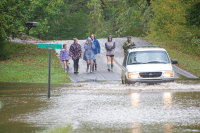Digging out Lake Junaluska … again
In the ongoing battle to keep Lake Junaluska from filling with silt, the lake will once again be partially lowered this winter so accumulated sediment can be dug out.
Scooping sediment out of the lake is a costly proposition. There have been four digs over the past decade, costing $1.7 million. Of that, $1.2 million came from state and federal grants, and Lake Junaluska Assembly contributed $500,000.
When the first “big dig” was undertaken at the beginning of the decade, so much sediment had accumulated it was a mere four to eight inches from the lake’s surface around the mouth of Richland Creek.
“At that point we were in danger of losing that whole west end of the lake,” said Jimmy Carr, executive director of Lake Junaluska.
Carr and his team first had to play catch-up before putting in place a plan to keep sediment at bay with smaller digs every other year.
“The problem will never be solved. What we are trying to do is get it so it is manageable,” said Buddy Young, director of residential services with Lake Junaluska Assembly.
To set the stage for periodic clean-outs, the lake bottom was reshaped near the mouth of Richland Creek to confine sediment being dumped into the lake into one area, making it easier for the bulldozer operators to get at.
This next round of sediment dredging will cost $300,000 — with half coming from the state and half from Lake Junaluska Assembly.
Lake Junaluska requested $350,000 for the dredging back in 2009, but it didn’t come through that year. Carr said the assembly is thankful Sen. Joe Sam Queen, D-Waynesville, continued to fight for the appropriation.
“He really stayed with it in a very difficult budgeting time,” Carr said.
The economic impact of Lake Junaluska Assembly on the entire region helped win the funding.
“Lake Junaluska is a valuable asset to the Haywood Community and the entire region,” said Queen.
Lake Junaluska Conference and Retreat Center attracts 100,000 people each year for dozens of conventions held on its grounds, with an annual economic impact in the millions plus intangible benefit of outside exposure.
The sediment piling up in Lake Junaluska is a countywide problem. One only has to look at the color of Richland Creek during a heavy rain to see the mud and erosion making its way into the water.
“When it hits the lake it slows and the silt settles out,” Carr said.
The lake can be unsightly while work is being done. Lower water levels expose a ring of mud around the shore in the main part of the lake, and a mudflat in shallower areas. The work usually raises eyebrows.
“I think a lot of the locals understand this is a regular thing, but for visitors to the area it is the No. 1 question we get during the draw down: is there something wrong with the lake and why are you doing this?” said Ken Howle, marketing director for Lake Junaluska Assembly.
Though there has been some discussion of sacrificing the lake at the mouth of Richland Creek and allowing it to become a wetland, Young said it would not be a good route to take.
“It is not like it would build up a good quality wetland. It would be a shifting sand bar,” Young said.
A couple of wetlands have been created in the shallow part of the lake, however, benefiting wildlife.
Sediment foils irrigation systems at worst possible time
During the past three weeks, tomato farmers in the Thomas Valley near Whittier have been unable at times to run drip irrigation equipment to counter drought conditions because sediment in the Tuckasegee River was clogging their pumps.
“With the 90-degree days, it’s really critical that these farms get drip irrigation,” said William Shelton, who runs a vegetable farm in Thomas Valley. “That river’s our lifeblood when it comes to these crops. Particularly during drought.”
Tomatoes are 85 percent water. When the plants are overstressed, they will actually take water back from the fruit, ruining the crop.
Kent Cochran, who farms 20 acres of tomatoes just up the road from Shelton, doesn’t understand how the river can be full of mud when there is no rain.
“When it rains, there’s going to be mud for a day or two but that’s not really an issue,” Cochran said. “We’ve been needing the water bad these past three weeks, and sometimes we go over there and it’s clear, and other days it’s mud.”
Robbie Shelton, the Jackson County erosion control officer, has been equally perplexed. Shelton’s job includes monitoring construction sites that could dump sediment into the river.
Last week, Robbie Shelton traveled up and down the river in search of an answer to the farmers’ questions. The focus of his investigation was Duke Energy’s efforts to restore the streambed above and below the former site of the Dillsboro Dam.
Shelton took pictures during the first week of July that showed the river was clear above the dam and increasingly turbid below.
“The Tuck upstream of the dam is clear. It’s downstream that it’s muddy,” Shelton said.
Shelton said during the drought, the river was increasingly muddy as it moved downstream towards Barker’s Creek.
“The closer you get to Thomas Valley the dingier it gets,” Shelton said. “It’s a progression. I’ve tried to find a source, and there’s not been one that’s been found.”
Nate Darnell, who works an 8-acre tomato field in Thomas Valley as part of his North Face Farm, has tried to bring some levity to an otherwise worrisome situation.
“As a farmer, I have to deal with a lot of runoff regulations, and it strikes me as ironic that the upstream runoff from development is causing us the problems now,” Darnell said
The restoration of the stream bank at the former Dillsboro Dam site is monitored daily by personnel from Duke Energy in accordance with the Clean Water Act and overseen by the N.C. Division of Water Quality.
Duke has been monitoring turbidity below its work zone. It has not exceeded state standards. In fact it has been well below them, according to Duke spokesperson Jason Walls.
“The turbidity and the sediment in the river are coming in from other places,” Walls said. “We feel confident that our operations aren’t increasing the levels of sediment.”
If the dam site isn’t causing the sediment, then what is?
That’s the question Cochran and Darnell are asking. Darnell has observed that on dry days the river gets turbid in the middle of the day.
“It was coming on down here about midday, anywhere between 11 a.m. and 1 p.m.,” Darnell said. “I really can’t give you a good reason, but I could speculate.”
So far this summer, Darnell estimates he has lost between one and three tomatoes from each of his plants. By the end of the season, those losses could add up to $25,000 in lost crops.
Darnell said farmers are constantly dealing with loss, whether from drought or insects or crows, but having the cause be the river that is the valley’s lifeblood is mystifying.
“The river’s not always going to be clear, but we really shouldn’t have to fight it during drought,” Darnell said.
Lake J seeks state help for dam, sediment
Lake Junaluska Assembly is asking Haywood County commissioners to help it land state grants for maintenance on the lake and dam.
The Assembly faces two major issues: repairs to the aging dam and sediment removal from the lake. An engineering study is needed for the spillways and gate controls in preparation for improvements to the dam.
Meanwhile, removing silt from the lake has become a regular maintenance chore every three to four years.
Lake Junaluska hopes to get $30,000 or 50 percent of the cost for the engineering from the state. The lake is seeking either $440,000 or 66.6 percent of the cost for the sediment removal project. In both cases the state would provide whichever is less.
The Assembly will pay for the rest from its own funds, according to Jimmy Carr, director of Lake Junaluska Assembly.
The Haywood County Board of Commissioners plans to vote on an endorsement of the application at its next meeting on Sept. 21, after wording on the proposal has been changed to ensure financial and legal responsibility for the projects rests solely with the Assembly. Once approved, Haywood County would request the state funds on the Assembly’s behalf.
The Assembly has already spent $3.3 million on renovating the dam over the past six years. While Carr says the dam is “very safe” and no critical improvements are needed, work on the dam is not over.
According to the Assembly, the spillway is not in as good a shape as hoped, but that there is no cause for alarm. The study would be part of a general effort to maintain the dam.
The goal of the proposed dam study is to have engineers determine the extent of problems with the spillway, so the Assembly can make financial and structural plans to fix them.
At the moment, the more costly project deals with sediment removal, with much of the expense going toward creating a disposal site on top of Sleepy Hollow Road on property the Assembly already owns.
While the cost of building such a site is “a big unknown,” the proposed disposal site could be used for decades to come, said Buddy Young, director of residential services, at Tuesday’s commissioners meeting.
Since 2001, the Assembly has done extensive sediment removal from Lake Junaluska.
“In one year, we removed 5,500 loads of silt from the lake,” said Carr. If it isn’t removed, it could fill the lake up over time, Carr said.
As development has increased on mountain slopes in recent years, so has erosion. Sediment washing off construction sites and into creeks is ultimately deposited in Lake Junaluska downstream.
According to Carr, there has been a lot of community support, both from Haywood Waterways Association and county officials, to enforce erosion policies.
Dam Break: Scale of disaster leaves community reeling
A dam broke on an irrigation pond at Balsam Mountain Preserve in Jackson County two weeks ago unleashing hundreds of tons of mud downstream.









